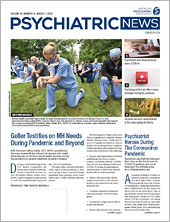Despite the continuing COVID-19 pandemic and associated physical distancing orders, psychiatrists are still finding ways to engage with lawmakers and advocate on professional issues and for their patients.
Last month, two Ohio psychiatrists participated in a virtual town hall with Rep. Troy Balderson (R-Ohio) along with physicians from other specialties to share what legislation and regulatory policies are needed in response to the COVID-19 pandemic.
Nita Bhatt, M.D., M.P.H., and Alan Levy, M.D., both members of APA’s Congressional Advocacy Network, emphasized to Balderson the need to extend relaxed telehealth regulations beyond the pandemic and to enforce mental health parity laws. Bhatt is an assistant professor of psychiatry at Wright State University, and Levy is a past president of the Ohio Psychiatric Physicians Association (OPPA) and chair of OPPA’s Telepsychiatry Committee.
“This was a unique opportunity because it was the first town hall of its type,” Bhatt said. “It allowed me to advocate with physicians from across the nation practicing in a diverse range of specialties including orthopedic surgery and emergency medicine.”
During the virtual town hall, Bhatt and Levy expressed support for the Mental Health Parity Compliance Act (HR 3165), sponsored by Reps. Katie Porter (D-Calif.), Gus Bilirakis (R-Fla.), and Donald Norcross (D-N.J.). The legislation would ensure health plans are transparent and accountable in covering treatment for mental and substance use disorders equal to that for other medical conditions.
Balderson has already indicated his support of telehealth, Levy said. “We were really preaching to the choir.” Levy added, however, that it’s still invaluable for psychiatrists to express their views even to legislators who appear to agree with them.
“It’s one thing to try and secure a legislator’s vote, but it’s another to have that legislator share the passion that we have for the bills because then they can influence the votes of others who might be on the fence or who aren’t so well educated about this topic,” he said.
Bhatt has been participating in advocacy since she was an intern in 2013. She’s seen APA’s advocacy efforts result in real change, including increased access to Medicare services and increased funding for mental health programs and fellowship programs, among many other results. “Advocacy is a way for psychiatrists to share their expertise and experiences and to help shape policy and laws related to mental illness, substance use, and health care in general,” she said.
Getting involved with advocacy can be intimidating, Levy and Bhatt pointed out. But even when Bhatt first began advocating as an intern, she said, legislators still saw her as a doctor and valued her opinion. She urged her fellow psychiatrists to get involved in advocacy efforts.
For psychiatrists who wish to do so, a great place to start is by contacting APA’s Department of Government Relations, said Sage Bauer, APA’s federal and state grassroots and political action committee manager.
Staff provide advocates with all the resources they need—including talking points—to prepare to speak with a member of Congress. In addition, interested psychiatrists are invited to join the Congressional Advocacy Network.
Bhatt and Levy also recommended that members reach out to their local district branch for opportunities to shape policies in their state. “Psychiatrists are in a unique position to educate,” Levy said. “Just as we educate our patients, their families, and the next generation of psychiatrists, we need to educate the public and legislators. Legislators really value that education.” ■
Information on how to join the Congressional Advocacy Network is posted
here.


